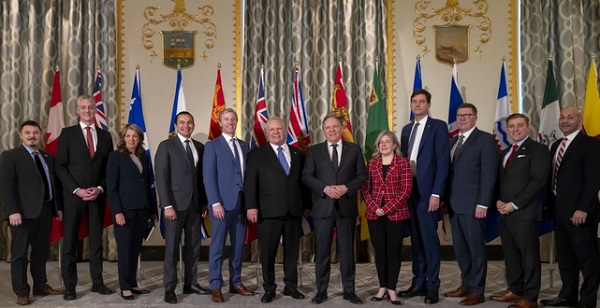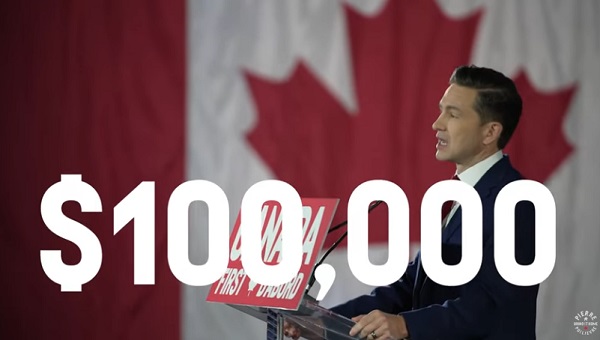Business
Premiers Rally For Energy Infrastructure To Counter U.S. Tariff Threats

From the Frontier Centre for Public Policy
With U.S. tariffs looming, Premiers push for border security, pipelines, and interprovincial trade reform
After more than eight years of federal policies that have challenged the oil and gas industry, imagining Canadian energy policy in a post-Trudeau era is no easy task.
However, recent meetings addressing the threat of United States tariffs may offer hope for revisiting energy policies through provincial collaboration.
The January 2025 Council of the Federation meetings, attended by all 13 provincial and territorial premiers, produced several key value propositions.
- After spending a week in Washington, D.C., meeting with Donald Trump and his administration, Alberta Premier Danielle Smith highlighted the provinces’ resource strengths.
- British Columbia can leverage germanium—a critical mineral essential in defence applications that China will no longer export to the U.S.
- Saskatchewan’s uranium supply offers an alternative to reliance on Kazakhstan and Russia.
- Canadian provinces can provide resources that align with U.S. energy goals.
Any provincial initiatives must also address U.S. priorities, including tighter border security and increased defence spending.
To meet U.S. energy security needs, Canada must remove policy barriers hindering development. Policies like the Clean Energy Regulations (CER), the emissions cap, and the net-zero vehicle mandate (starting January 2026) are significant challenges. Provinces must collaborate to amend or remove these policies, ensuring they do not survive the next federal election. Alberta and Saskatchewan have already opposed the CER, and the proposed emissions cap remains under review.
The federal government acknowledges that these policies must be re-evaluated to avoid obstructing shared energy goals, including:
- carbon pollution pricing
- methane regulations
- clean fuel standards
- carbon capture incentives
- emissions reduction funding
- clean growth programs
- best-in-class guidelines for new oil and gas projects under federal review.
The U.S.’s energy deficit—20 million barrels consumed daily versus 13 million produced—creates an opportunity for Canada. Achieving this requires dismantling interprovincial trade barriers and developing infrastructure projects from coast to coast. The Council meetings have initiated such collaboration, with ongoing bilateral discussions expected. Infrastructure projects like pipelines to the East and West coasts would enable Canada to supply the U.S. and other global markets, reducing reliance on hostile regimes.
Newfoundland and Labrador Premier Andrew Furey stated: “I see energy as Canada’s queen in the game of chess. We don’t need to expose our queen this early. The opposition needs to know that the queen exists, but they don’t need to know what we’re going to do with the queen.”
Saskatchewan Premier Scott Moe and Alberta Premier Danielle Smith have rejected measures that would affect Canada’s energy exports to the U.S.
“When you look at the pipeline system, how oil is actually transported into the U.S. and back into Canada,” Moe said, “it would be very difficult, and I think impossible operationally to even consider.” Manitoba Premier Wab Kinew emphasized the importance of national unity, stating that energy decisions must not fracture the country. Ontario Premier Doug Ford warned that tariffs could cost Ontario 500,000 jobs, while P.E.I. Premier Dennis King noted that tariffs could cost 25 per cent of P.E.I.’s GDP and 14,000 jobs—a catastrophic loss for the province.
The Council meetings highlighted three key priorities:
- Demonstrate Canada’s commitment to border security and meet its two per cent GDP NATO target.
- Build oil and gas pipelines east and west to diversify markets and remove interprovincial trade barriers, enabling a stronger national economy.
- Secure provincial consent before imposing export tariffs or restrictions that could harm individual provinces.
This emerging consensus underscores that Canada’s energy future depends on proactive, constructive diplomacy with U.S. lawmakers, supported by a unified provincial front and practical energy policies that benefit both nations.
Maureen McCall is an energy business analyst and Fellow at the Frontier Center for Public Policy. She writes on energy issues for EnergyNow and the BOE Report. She has 20 years of experience as a business analyst for national and international energy companies in Canada.
Internet
US government gave $22 million to nonprofit teaching teens about sex toys: report

From LifeSiteNews
The Center for Innovative Public Health Research’s website suggests teenage girls make their ‘own decisions’ about sex and not let their parents know if they don’t want to.
For almost a decade, the U.S. government funded a group that actively works to teach kids how to use sex toys and then keep them hidden from their parents to the tune of $22 million.
According to investigative reporter Hannah Grossman at the Manhattan Institute, The Center for Innovative Public Health Research (CIPHR) has been educating minors about sex toys with public funds.
Records show that the millions given to the group since 2016, according to its website, go toward “health education programs” that “promote positive human development.”
However, the actual contents of the programs, as can be seen from comments from CIPHR CEO Michele Ybarra, seem to suggest that its idea of “human” development is skewed toward radical sex education doctrine.
In 2017, CIPHR launched Girl2Girl, which is funded by federal money to promote “sex-ed program just for teen girls who are into girls.” Its website lets users, who are girls between ages 14 and 16, sign up for “daily text messages … about things like sex with girls and boys.”
The actual content of some of the messages is very concerning. Its website notes that some of the texts talk about “lube and sex toys” as well as “the different types of sex and ways to increase pleasure.”
The website actively calls upon teenage girls to make their “own decisions” and not let their parents know if they don’t want to.
Grossman shared a video clip on X of Ybarra explaining how they educate minors about the use of “sex toys” and dealing with their parents if they are found out.
The clip, from a 2022 Brown University webinar, shows Ybarra telling researchers how to prepare “young person(s)” for her research.
She said if they are doing “focus groups,” she will ask them, “Okay, so what happens if somebody comes into the room and sees words like penis and sex toys on your screen — on your computer screen or on your phone? What if it’s your mom?’”
In 2023, CIPHR launched Transcendent Health, which is a sex-education program for minors who are gender confused. This initiative received $1.3 million of federal grant money that expired last month.
Grossman observed that the federal government “should not fund programs that send sexually explicit messages to minors and encourage them to conceal these communications from parents.”
She noted that in order to protect children and “prevent further harm,” U.S. President Donald Trump’s Department of Health and Human Services “should immediately cancel CIPHR’s active contract and deny its future grant applications.”
“By doing so, the Trump administration can send a clear message: Taxpayers will no longer foot the bill for perverted ‘research’ projects,” she noted.
The Trump administration has thus far, through the Department of Government Efficiency (DOGE), exposed billions in government waste and fraud. Many such uses of taxpayer dollars are currently under review by the administration, including pro-abortion and pro-censorship activity through USAID, “Diversity, Equity, and Inclusion and neo-Marxist class warfare propaganda” through the National Science Foundation, and billions to left-wing “green energy” nonprofits through the Environmental Protection Agency.
Business
Canadian Police Raid Sophisticated Vancouver Fentanyl Labs, But Insist Millions of Pills Not Destined for U.S.

 Sam Cooper
Sam Cooper
Mounties say labs outfitted with high-grade chemistry equipment and a trained chemist reveal transnational crime groups are advancing in technical sophistication and drug production capacity
Amid a growing trade war between Washington and Beijing, Canada—targeted alongside Mexico and China for special tariffs related to Chinese fentanyl supply chains—has dismantled a sophisticated network of fentanyl labs across British Columbia and arrested an academic lab chemist, the RCMP said Thursday.
At a press conference in Vancouver, senior investigators stood behind seized lab equipment and fentanyl supplies, telling reporters the operation had prevented millions of potentially lethal pills from reaching the streets.
“This interdiction has prevented several million potentially lethal doses of fentanyl from being produced and distributed across Canada,” said Cpl. Arash Seyed. But the presence of commercial-grade laboratory equipment at each of the sites—paired with the arrest of a suspect believed to have formal training in chemistry—signals an evolution in the capabilities of organized crime networks, with “progressively enhanced scientific and technical expertise among transnational organized crime groups involved in the production and distribution of illicit drugs,” Seyed added.
This investigation is ongoing, while the seized drugs, precursor chemicals, and other evidence continue to be processed, police said.
Recent Canadian data confirms the country has become an exporter of fentanyl, and experts identify British Columbia as the epicenter of clandestine labs supplied by Chinese precursors and linked to Mexican cartel distributors upstream.
In a statement that appears politically responsive to the evolving Trump trade threats, Assistant Commissioner David Teboul said, “There continues to be no evidence, in this case and others, that these labs are producing fentanyl for exportation into the United States.”
In late March, during coordinated raids across the suburban municipalities of Pitt Meadows, Mission, Aldergrove, Langley, and Richmond, investigators took down three clandestine fentanyl production sites.
The labs were described by the RCMP as “equipped with specialized chemical processing equipment often found in academic and professional research facilities.” Photos released by authorities show stainless steel reaction vessels, industrial filters, and what appear to be commercial-scale tablet presses and drying trays—pointing to mass production capabilities.
The takedown comes as Canada finds itself in the crosshairs of intensifying geopolitical tension.
Fentanyl remains the leading cause of drug-related deaths in Canada, with toxic supply chains increasingly linked to hybrid transnational networks involving Chinese chemical brokers and domestic Canadian producers.
RCMP said the sprawling B.C. lab probe was launched in the summer of 2023, with teams initiating an investigation into the importation of unregulated chemicals and commercial laboratory equipment that could be used for synthesizing illicit drugs including fentanyl, MDMA, and GHB.
The Bureau is a reader-supported publication.
To receive new posts and support my work, consider becoming a free or paid subscriber.
Invite your friends and earn rewards
-

 2025 Federal Election1 day ago
2025 Federal Election1 day agoRCMP memo warns of Chinese interference on Canadian university campuses to affect election
-

 Alberta2 days ago
Alberta2 days agoAlberta takes big step towards shorter wait times and higher quality health care
-

 2025 Federal Election1 day ago
2025 Federal Election1 day agoResearchers Link China’s Intelligence and Elite Influence Arms to B.C. Government, Liberal Party, and Trudeau-Appointed Senator
-

 Business2 days ago
Business2 days agoTrump raises China tariffs to 125%, announces 90-day pause for countries who’ve reached out to negotiate
-

 2025 Federal Election1 day ago
2025 Federal Election1 day agoThe status quo in Canadian politics isn’t sustainable for national unity
-

 2025 Federal Election1 day ago
2025 Federal Election1 day agoPoilievre Announces Plan To Cut Taxes By $100,000 Per Home
-

 Business1 day ago
Business1 day agoScott Bessent Says Trump’s Goal Was Always To Get Trading Partners To Table After Major Pause Announcement
-

 2025 Federal Election22 hours ago
2025 Federal Election22 hours agoTwo Canadian police unions endorse Pierre Poilievre for PM






